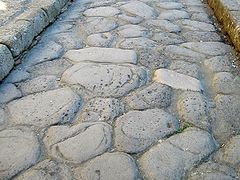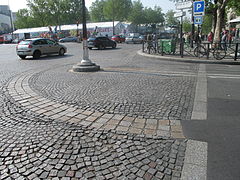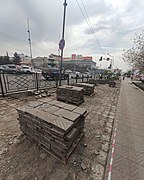

A paver is a paving stone, tile, brick or brick-like piece of concrete commonly used as exterior flooring. They are generally placed on top of a foundation which is made of layers of compacted stone and sand. The pavers are placed in the desired pattern and the space between pavers that is created with the integrated spacer bar is then filled with concrete sand or a polymeric sand. No actual adhesive or retaining method is used other than the weight of the paver itself except edging. Pavers can be used to make roads, driveways, patios, walkways and other outdoor platforms.
In a factory, concrete pavers are made with a mixture of sand, stone, cement and iron oxide pigments in a mold and then cured prior to packaging.
Block paving
Block paving, also known as brick paving, is a commonly used decorative method of creating a pavement or hardstanding. The main benefit of bricks over other materials is that individual bricks can later be lifted up and replaced. This allows for remedial work to be carried out under the surface of the paving without leaving a lasting mark once the paving bricks have been replaced. Typical areas of use would be for driveways, pavement, patios, town centres, pedestrian precincts and more commonly in road surfacing. Bricks are typically made of concrete or clay, though other composite materials are also used. Each has its own means of construction. The biggest difference is the way they set hard ready for use. A clay brick has to be fired in a kiln to bake the brick hard. A concrete brick has to be allowed to set. The concrete paving bricks are a porous form of brick formed by mixing small stone hardcore, dyes, cement and sand and other materials in various amounts. Many block paving manufacturing methods are now allowing the use of recycled materials in the construction of the paving bricks, such as crushed glass and crushed old building rubble.
There are many different laying patterns that can be achieved using block paving. The most common of these is the herringbone pattern. This pattern is the strongest of the block paving bonds as it offers the most interlock, therefore making it a good choice for driveways and road surfacing. A herringbone pattern can be created by setting the blocks at either 45 degrees or 90 degrees to the perpendicular. Other popular types of pattern include stretcher bond and basketweave; with the latter being better suited to paved areas that will only receive light foot traffic, due to its weaker bond.
A commonly used base is 'cracker dust' or commonly known as crushed bluemetal. The advantage of using this in residential living is that it compacts a lot harder than yellow brickies sand, which prevents weeds and ants from coming through.
Concrete pavers

Pavers come in a number of styles, shapes and tones. Pavers manufactured from concrete go well with flag, brick and concrete walkways or patios. Concrete pavers may be used where winter temperatures dip below freezing. They are available in hole, x-shape, y-shape, pentagon, polygon and fan styles.
An interlocking concrete paver, also known as a segmental paver, is a type of paver. This paver has emerged over the last couple of decades as a very popular alternative to brick, clay or concrete. An interlocker is a concrete block paver which is designed in such a way that it locks in with the next paver. The locking effect allows for a stronger connection between pavers and with this interlocking effect the paving itself is resistant to movement under traffic.
Segmental pavers have been used for thousands of years. The Romans built roads with them that are still there. But it was not until the mid-1940s that pavers began to be produced out of concrete. It started in the Netherlands where all the roads are made to be flexible because much of the country is below sea level and the ground shifts, moves and sinks. Poured concrete is not an option because it will crack. Individual units not set in concrete, and placed in sand perform far better than concrete. Before the paver was made from concrete, either real stone or a clay product was used.
The first production of concrete pavers in North America was in Canada, in 1973. Due to their success, paving stone manufacturing plants began to open throughout the United States working their way from east to west.
The first concrete pavers were shaped just like a brick, 4 by 8 inches (100 mm × 200 mm), and they were called Holland Stones. These units turned out to be economical to produce and were exceedingly strong.
In addition to being economical, interlocking concrete pavers are also widely available in water-permeable designs, which have added ecological benefits. By allowing water to drain through the pavers in a way that mimics natural absorption, builders and landscapers are able to limit surface runoff and prevent soil erosion or buildup of standing water in the surrounding land area. Some permeable paver installations are designed to harvest rainwater, which can then be repurposed for uses such as irrigation or washing a car. Permeable paver applications have also been found to offer benefits in filtering contaminants of the water being captured.
Modern installation method
Pavers must have a strong base, a flat bedding and an edge restraint.
Base
To prevent the soil from absorbing the base layer above, there should be a compacted sub-base (which is the naturally occurring soil) and a layer of landscape fabric. Landscape fabric is not required in every application. All compaction is usually performed with a plate compactor or hand tamper. All sand-containing materials (e.g., concrete sand, rock dust, or minus crushed rock) must be soaked with water for effective compaction. The base layer should be 6" deep for walkways, or 12" deep for driveways. The base material should either be 3/4" crushed stone (to allow water to drain through it) for a 1/4" crushed stone bedding, or 3/4" minus crushed stone (to prevent sand from sinking through it) for a concrete sand bedding. The base should be compacted every 6". If the base layer is deeper than 6", then biaxial geogrid should be added every 6" and spaced evenly throughout the bedding to maintain stability. If reliable concrete is already installed that can be used as the base layer.
Bedding
Above the base layer, there should be a 1" bedding layer. A 1/4" crushed stone bedding material is favored over concrete sand on walkways for its better drainage that mitigates freeze-thaw shifting, easier compaction especially on rainy days, and less weed growth. A concrete sand (specifically ASTM C33) bedding is preferable for building driveways with tighter joints (i.e., thinner cracks) because the sand is small enough to be raised up into the cracks when the pavers are compacted. This raised concrete sand helps lock the pavers in place so that they can handle more weight.
Concrete sand is a more preferable bedding layer than rock dust. Because rock dust retains rather than drains water, it prevents polymeric sand from drying and curing. Additionally, when that water in the rock dust eventually evaporates, it will carry salts through the pavers which will deposit on their surface and stain them with "efflorescence build-up". Additionally, compacting pavers levels them easier on sand than on rock dust.
The bedding layer must be flattened by "screeding" it. To screed the bedding, scrape a straightedge (such as a level) along the top of the bedding. To guide the straightedge, it is common to place parallel metal rails on top of the bedding, or have 1" PVC pipes laid on the base so that they reach the top of the bedding. If using pipes, their indentation must be filled with bedding material once removed. A slight slope towards a drain is usually implemented. The pavers are hammered with a mallet when placing them down to help them settle and prevent them from wobbling.
Edge restraint and sealing
Edge restraints prevent pavers from spreading apart and maintain the integrity of the pavement system to move uniformly with freeze thaw cycles as well. An edge restraint can be a concrete slope which is no steeper than 45 degrees, and meets the edge pavers halfway between its top and bottom surface so that it can be buried. Alternatively, commercial plastic edge restraints can be anchored into the ground with steel spikes.
After the pavers have been laid and cleaned with a pressure washer, and they must be dried according recommendations the particular polymeric sand (usually at least for one hot summer day). After they have been dried, sweep the polymeric sand into the cracks, then compact the pavers to help the sand sink in (often with a wood panel between the pavers and the compactor to prevent chipping the pavers), and then rinse according to the polymeric sand's instructions. This sand prevents weeds from growing between them, and helps them lock into place. Do not sweep the polymeric sand more than 10 feet from where it was poured because it will sift out necessary additives. Note that different types of polymeric sand can handle different joint widths and depths, and they often have require slightly different methods of rinsing. Applying paver sealer or concrete sealer bi-annually prevents stains from getting on the pavers.
Stone pavers
A stone paver is another type of paver. This type of paver is used widely in building and landscaping as it is highly prized for beauty, strength and durability. Stone pavers are made of many materials including limestone, bluestone, basalt (such as that from The Palisades used in New York City), sandstone and granite.
Travertine is a durable, low-porous stone that stays cool in direct sunlight, making it a popular choice for pool-sides, patios, walkways and outdoor entertainment areas. Travertine is salt tolerant and has a low sunlight reflection. Granite pavers have high integral strength and density making it easy to maintain and hard-wearing in outdoor use. Limestone pavers are cut from natural limestone blocks, a sedimentary rock found in mountainous areas and ocean sea beds. Limestone tends to have unique natural colour variations. Sandstone pavers are derived from natural stone and tend to be used for sidewalks, patios and backyards.
-
 Roman stone pavement in Herculaneum
Roman stone pavement in Herculaneum
-
 Cobblestone pavement in Italy
Cobblestone pavement in Italy
-
 Cobblestone pavement in Cres, Croatia
Cobblestone pavement in Cres, Croatia
-
 Cobblestone pavement in Porvoo, Finland
Cobblestone pavement in Porvoo, Finland
-
 Belgian block street in Philadelphia
Belgian block street in Philadelphia
-
 Sett pavement in Paris
Sett pavement in Paris
-
 Permeable pavement
Permeable pavement
-
 Portuguese pavement of black basalt and white limestone in Lisbon
Portuguese pavement of black basalt and white limestone in Lisbon
-
Brick pavement in Piazza del Campo, Siena
-
 Hexagonal trylinka patented in 1933 by Władysław Tryliński, crumbling in New York
Hexagonal trylinka patented in 1933 by Władysław Tryliński, crumbling in New York
-
 Wood paving may be used indoors as a flooring material
Wood paving may be used indoors as a flooring material
-
 Laying paving slabs in the center of Ulan-Ude, Russia
Laying paving slabs in the center of Ulan-Ude, Russia
-
 Pavement of forecourt of Abbaye Saint-Pierre of Uzerche, France
Pavement of forecourt of Abbaye Saint-Pierre of Uzerche, France
See also
References
- "paver" def. 2. Oxford English Dictionary Second Edition on CD-ROM (v. 4.0) Oxford University Press, 2009
- "Paving brick". The Free Dictionary.com accessed May 1, 2014
- ^ "The Segmental Concrete Pavement Industry | Interlocking Concrete Pavement Institute". Archived from the original on October 7, 2015. Retrieved June 9, 2015.
- Ritchie, Gill (March 20, 2019). "Concrete Interlocking pavers for commercial and residential use". C.E.L. Paving Products. Retrieved June 23, 2020.
- "Los Angeles Pavers - The History of the Interlocking Paver". Pacific Pavingstone. Retrieved September 13, 2020.
- "Belgard Commercial". Permeable Interlocking Concrete Pavement (PICP). Retrieved May 26, 2017.
- Friskly, Mrs. "Granite Paving". Retrieved August 25, 2022.
- Belgard. "Permeable Pavers". Archived from the original on January 11, 2018. Retrieved February 17, 2017.
- ^ "Best Base for Pavers - How to Hardscape". August 20, 2021. Retrieved November 23, 2023.
- ^ "Construction Tolerances and Recommendations for Interlocking Concrete Pavements". ICPI. April 1, 2020. Retrieved November 24, 2023.
- "Choosing the Right Paver Base Material | JM Mento Landscape Design". jmmentolandscapedesign.com. February 15, 2021. Retrieved November 23, 2023.
- "Geogrid Installation, Types, and Applications - How to Hardscape". August 14, 2021. Retrieved November 23, 2023.
- "Stop Using Limestone Screenings / Crusher Dust / Stone Dust for Pavers - How to Hardscape". December 23, 2020. Retrieved November 24, 2023.
- Cambridge Sand vs Stone Dust, January 24, 2017, retrieved November 24, 2023
- ^ https://extension.oregonstate.edu/sites/default/files/documents/1/howtoinstallpavers.pdf
- Finn, Casey (October 28, 2022). "How To Install Polymeric Sand In Your Pavers | The DIY Playbook". DIY Playbook. Retrieved November 23, 2023.
- "How to Install Concrete Pavers: 11 Steps (with Pictures)". wikiHow. Retrieved November 23, 2023.
- "Polymeric Sand Installation, Problems, and Solutions - How to Hardscape". April 12, 2020. Retrieved November 23, 2023.
- Tillson, George William (1912), "Cobble and stone-block pavements", Street pavements and paving materials: A manual of city pavements: the methods and materials of their construction. For the use of students, engineers, and city officials, J. Wiley & Sons, 1912, pp. 189–227
External links
 Media related to Pavements (architecture) at Wikimedia Commons
Media related to Pavements (architecture) at Wikimedia Commons